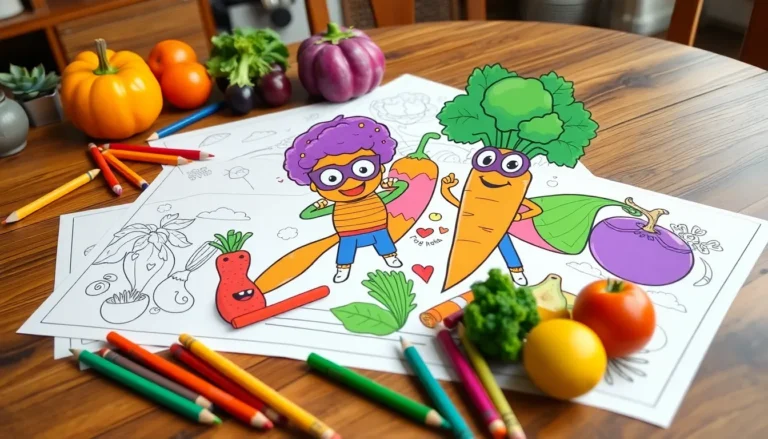Getting a toddler to eat can feel like trying to negotiate with a tiny dictator. One minute they’re all about broccoli, and the next, they’re on a strict cookie-only diet. Parents everywhere know the struggle, and it often leads to mealtime battles that can leave everyone feeling defeated. But it doesn’t have to be this way!
Table of Contents
ToggleUnderstanding Toddler Nutrition
Nutrition plays a vital role in a toddler’s growth and development. Balanced meals support physical and cognitive growth, ensuring children get essential nutrients. Serving a variety of foods promotes a well-rounded diet. Fruits, vegetables, whole grains, proteins, and dairy products provide necessary vitamins and minerals.
Parents should focus on portion sizes. Serving smaller amounts can reduce mealtime stress for both parents and toddlers. Recognizing that toddlers’ stomachs are small helps set realistic expectations for how much they can eat. Encouraging children to listen to their own hunger cues fosters healthy eating habits.
Variety matters in maintaining interest in meals. Rotating food options and presenting meals in different ways keeps mealtime exciting. Combining foods or letting children choose their favorites can increase willingness to try new items. Creative presentation, like arranging food in fun shapes, may also capture a toddler’s attention.
Consistency in mealtime routines benefits toddlers. Establishing regular meal and snack times helps create structure. A calm environment during meals encourages engagement and reduces anxiety associated with trying new foods. Parents can join children at the table to model positive eating behaviors.
Allergies or food intolerances might affect a toddler’s diet. Therefore, parents should monitor responses when introducing new foods. Consulting a pediatrician ensures that a child’s nutritional needs are met effectively while avoiding harmful ingredients.
Understanding the fundamentals of toddler nutrition allows parents to tackle mealtime challenges head-on. Keeping meals varied, maintaining routines, and prioritizing nutrition will lead to healthier eating habits in young children.
Common Feeding Challenges

Mealtime can pose several challenges for parents of toddlers. Understanding these difficulties helps in finding effective solutions.
Picky Eaters
Picky eaters frequently refuse to try new foods, causing frustration. Preferences can change daily, making it hard for parents to plan meals. Introducing a variety of options at a relaxed pace encourages exploration. Plating colorful foods increases visual appeal and entices toddlers. Modeling positive behaviors by eating together can foster willingness. Rewards for trying new foods, such as praise, can motivate toddlers. Creating a non-pressured environment helps reduce resistance and promotes a more enjoyable experience.
Short Attention Span
Toddlers often exhibit short attention spans during meals, leading to distractions. Frequent interruptions, such as toys or screens, can divert their focus. Keeping meals brief and engaging aids concentration. Simple games or stories at the table can maintain interest. Sitting down with engaging activities enhances their willingness to eat. Frequent small meals rather than three large ones can accommodate their fleeting focus. Implementing consistent mealtime routines typically stabilizes attention during meals.
Strategies to Encourage Eating
Encouraging toddlers to eat can transform mealtime into a positive experience.
Make Food Fun
Creating a playful atmosphere at mealtimes increases engagement. Incorporate shapes and colors into dishes to capture attention. Use cookie cutters to form fun shapes from fruits or sandwiches. Offering dips for vegetables makes eating interactive. Involving storytelling with food turns meals into adventures, enhancing interest in healthy options. Engaging toddlers with themed meals can spark excitement; for example, a “colorful plate” day featuring only colorful foods. Encourage imaginative names for dishes, like “dinosaur broccoli” or “rocket apple slices.” This approach cultivates curiosity and makes them more likely to try new foods.
Involve Your Toddler in Meal Prep
Encouraging participation in meal preparation fosters ownership over food choices. Let toddlers wash vegetables or mix ingredients under supervision. Simple tasks, such as choosing toppings for their own pizzas, increase excitement about eating. Assign them age-appropriate responsibilities, like setting the table or stirring ingredients. Making grocery shopping a fun adventure by letting them pick out fruits and vegetables engages their interest in food. Offering selected choices empowers them to express preferences. Increasing hands-on experiences can enhance their willingness to try what they’ve helped prepare.
Building Healthy Eating Habits
Establishing healthy eating habits during toddlerhood sets the foundation for lifelong nutrition. Parents can create a positive environment by serving a variety of foods every day. Balanced meals that include fruits, vegetables, whole grains, proteins, and dairy promote growth. Portion sizes matter; serving smaller amounts reduces stress and encourages exploration.
Consistency in mealtimes creates comfort. Toddlers thrive on routine, making it easier for them to know what to expect. Rotating food options keeps meals exciting and fosters curiosity about different flavors. Creative presentations engage little ones, making vegetables more appealing. Adding a fun twist, such as using cookie cutters or colorful plates, can spark their interest.
Encouraging involvement in meal prep empowers toddlers. Simple tasks like washing vegetables or choosing pizza toppings increase excitement about food. When kids feel a sense of ownership, they may be more likely to try new options. Engaging them with themed meals creates a playful atmosphere and encourages exploration of various cuisines.
Positive role modeling plays a crucial role in shaping eating behaviors. Parents and caregivers should enjoy a variety of foods, demonstrating healthy habits in action. During meals, short attention spans can be managed by incorporating quick activities or storytime. Opting for frequent small meals can help sustain energy throughout the day while minimizing pressure at mealtime.
Monitoring for allergies or food intolerances is essential. Consulting a pediatrician ensures that nutritional needs are met and tailored to their individual circumstances. Implementing these strategies fosters a healthy relationship with food and smooths the mealtime process for both parents and toddlers.
Tips for Mealtime Success
Creating a positive mealtime environment encourages toddlers to eat. Use colorful plates and utensils to make meals visually appealing. Offering food in fun shapes or arranging it into smiles can spark interest.
Introduce variety by rotating fruits and vegetables regularly. Presenting the same foods repeatedly leads to boredom. Each week, try new ingredients or cooking methods to keep meals exciting.
Involve toddlers in meal preparation to foster a sense of ownership. Allowing them to wash vegetables or pick toppings boosts their interest. Simple tasks will engage them and encourage their willingness to try new dishes.
Keep mealtime routines consistent to establish predictability. Setting fixed times for meals helps toddlers understand when to expect food. Familiarity can reduce anxiety and tantrums surrounding eating.
Create a playful atmosphere by incorporating games. Short interactive stories or songs can entertain toddlers during meals. This engagement keeps their attention focused on food instead of distractions.
Encourage trying new foods by introducing them gradually. Pairing new items with familiar favorites makes them less intimidating. Positive reinforcement, like praise or a sticker, can motivate toddlers to explore new tastes.
Model healthy eating behaviors consistently. When parents enjoy a variety of foods, toddlers are more likely to mimic those choices. Sharing meals and showing excitement about healthy options can instill positive habits.
Finally, ensure meals are brief and stress-free. Prioritizing fun over pressure makes mealtime enjoyable. Offering frequent small meals instead of three large ones caters to their short attention spans and keeps energy levels stable.
Getting toddlers to eat can feel like a daunting task but with the right approach it can become a more manageable experience. By focusing on nutrition and creating a positive mealtime environment parents can foster healthier eating habits. Incorporating fun elements and involving toddlers in meal prep can make mealtimes enjoyable rather than stressful.
Establishing consistent routines and being patient with changing preferences helps build trust and reduces anxiety around food. Ultimately the goal is to encourage a lifelong positive relationship with food. With creativity and persistence parents can navigate this challenging phase and ensure their toddlers develop healthy eating habits that last a lifetime.





